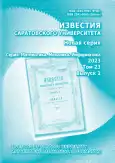Information processing for the decision support system for fire monitoring of forest areas
- 作者: Sorokin A.A.1, Maltseva N.S.1, Kutuzov D.V.1, Osovsky A.V.1
-
隶属关系:
- Astrakhan State Technical University
- 期: 卷 23, 编号 1 (2023)
- 页面: 126-138
- 栏目: Articles
- URL: https://journals.rcsi.science/1816-9791/article/view/250838
- DOI: https://doi.org/10.18500/1816-9791-2023-23-1-126-138
- EDN: https://elibrary.ru/PCOXKQ
- ID: 250838
如何引用文章
全文:
详细
作者简介
Alexander Sorokin
Astrakhan State Technical University16 Tatishcheva St., Astrakhan 414056, Russia
Nataliya Maltseva
Astrakhan State Technical University16 Tatishcheva St., Astrakhan 414056, Russia
Denis Kutuzov
Astrakhan State Technical University16 Tatishcheva St., Astrakhan 414056, Russia
Alexey Osovsky
Astrakhan State Technical University16 Tatishcheva St., Astrakhan 414056, Russia
参考
- Кухар И. В., Бердникова Л. Н., Орловский С. Н., Мартыновская С. Н., Коршун В. Н., Карнаухов А. И. Влияние вредных и опасных факторов лесных пожаров на окружающую среду // Хвойные бореальной зоны. 2019. Т. 37, № 5. С. 307–312. EDN: VKCKGD
- Соколов М. М. Стратегии России по введению трансграничного углеродного регулирования в ЕС // Геоэкономика энергетики. 2021. Т. 15, № 3. С. 84–97. https://doi.org/10.48137/2687-0703_2021_15_3_84
- Минаков Е. И., Калистратов Д. С., Мирчук С. Г. Модель информационно-измерительной системы видеомониторинга лесных пожаров // Известия Тульского государственного университета. Технические науки. 2017. № 11–2. С. 194–200. EDN: YSJJAO
- Губенко И. М., Рубинштейн К. Г. Сравнительный анализ методов расчета индексов пожарной опасности // Труды гидрометеорологического научно-исследовательского центра Российской Федерации. 2012. Вып. 347. С. 207–222. EDN: PTTLPP
- Wotton M. B. Interpreting and using outputs from the Canadian Forest Fire Danger Rating System in research applications // Environmental and Ecological Statistics. 2009. Vol. 16, iss. 2. P. 107–131. https://doi.org/10.1007/s10651-007-0084-2
- Sharples J. J., McRae R. H. D., Weber R. O., Gill A. M. A simple index for assessing fire danger rating // Environmental Modelling & Software. 2009. Vol. 24, iss. 6. P. 764–774. https://doi.org/10.1016/j.envsoft.2008.11.004
- Van Wagner C. E. Development and structure of the Canadian Forest Fire Weather Index System. Ottawa : Canadian Forestry Service, Headquarters, 1987. 35 p. (Forestry Technical Report, vol. 35). URL: https://cfs.nrcan.gc.ca/publications?id=19927 (дата обращения: 20.03.2022).
- Галушкин А. И. Нейронные сети: основы теории. Москва : Горячая Линия-Телеком, 2010. 496 с.
- Пегат А. Нечеткое моделирование и управление. Москва : БИНОМ. Лаборатория знаний, 2017. 800 с.
- Штовба С. Д. Проектирование нечетких систем средствами MATLAB. Москва : Горячая Линия-Телеком, 2007. 288 с.
- Lee K. H. First Course on Fuzzy Theory and Applications. Berlin ; Heidelberg : Springer, 2005. 335 p. https://doi.org/10.1007/3-540-32366-X
- Сорокин А. А. Усовершенствование информационно-аналитических комплексов на основе иерархических систем нечеткого логического вывода // Управление большими системами. 2020. Вып. 88. С. 99–123. https://doi.org/10.25728/ubs.2020.88.5
- Yager R. R., Filev D. P. Approximate clustering via the mountain method // IEEE Transactions on Systems, Man, and Cybernetics. 1994. Vol. 24, iss. 8. P. 1279–1284. https://doi.org/10.1109/21.299710
- Леонтьев В. К. О мерах сходства и расстояниях между объектами // Журнал вычислительной математики и математической физики. 2009. Т. 49, № 11. С. 2041–2058.
补充文件










